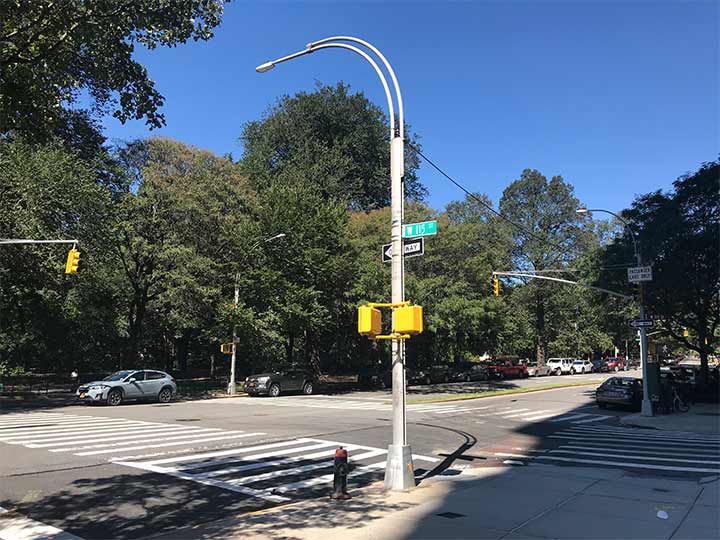
As is well known to readers of Forgotten New York, the slotted Donald Deskey lamps, whose design was created by the famed interior designer of Radio City Music Hall, was introduced on Broadway and Murray Street near City Hall in 1959 and by 1962 had begin to populate both city streets and also parkways and expressways. Their heyday was done by the early 1970s, but hundreds can still be found around town.
The original design vastly outnumbers its permutations such as the bronze 5th Avenue Twin Deskeys introduced in 1965. However, the design is eminently adaptable and has also been used for stoplights and longer-necked versions used on expressways. These were never very common but were also used on side streets such as Riverside Drive, shown here. This called for a twin bracket, but there’s a single version used on even wider roads that has longer necks and two attachments instead of the one we have here. In addition, there’s am extra-long twin Deskey that has a lengthy crossbar connecting the two necks. It looked wild in 1962 and still looks like something out of the future even today. One of these days I’ll gather them all on one page.
As always, “comment…as you see fit.” I earn a small payment when you click on any ad on the site.
5/24/22


7 comments
I like your idea for a page dedicated soley to Desky lamps
There is a very unusual double Deskey in front of the school located at 6016 18th avenue in Brooklyn. The twin arms resemble those on the Fifth avenue poles. The google street view is from oct. 2021. You can see why the Deskeys used the original aluminum base for only the first few years of their installations. The slightest contact with a vehicle resulted in gouging the soft aluminum. After about 1968 the deskeys were installed with the standard steel base.
My earliest memory of the Deskey is from 1964 when they were installed on a part of Church Av in Brooklyn, replacing cast irons during the widespread conversion from incandescent to mercury lights.
It should be interesting to note that light fixtures them selves were upgraded a few years back with LEDs replacing sodium vapor bulbs (or other type of bulbs).
An interesting feature of the new LED light heads is that if the power goes out due to power failure, the light heads go into a ‘strobe’ mode (I would not know what else to call it) and flash every few seconds so the area is never 100% dark. One minor drawback is that if the power loss happens in the daytime, the strobe effect will still happen since there is no powered control to the lights.
This happened not too long ago, when there was a Con Ed problem on Bartow Avenue and along Co-op City Blvd. All the street lights were strobing. It was a very weird effect. The power loss lasted into the morning hours.
The quarter loop arms were a failed street light design. The arms would loosen from the slotted masts over time. City had to place metal bands near the mast arm bolt to prevent separation during high winds.
The “strobing” that Mr. Berlin saw is not the result of a power failure. If there was a power failure the lights would not operate.
Jodie Lane was a young women walking her dogs in Greenwich Village when she noticed them acting strangely. When she reached down to her dogs she came in contact with an energized Con Edison manhole and was killed. An improperly insulated splice in a manhole flooded with water containing road salt had allowed the cover to become electrified. “ Jodies’ Law” passed by New York State requires all New York State utilities to periodically test every piece of their equipment for what is called ”stray voltage”.
Since 2007, every N.Y.C. Street light luminaire has been equipped with a voltage sensor. There are certain wiring faults, either within the street light pole or the Con Edison supply to the pole, that would allow the steel or aluminum pole to become energized with 120 volts. Anyone touching the pole would be subject to a severe shock or electrocution.
If you look up at the street light luminaire, you can see what appears to be a small hole about an inch back from the light source.
This is a red led that illuminates when the voltage sensor detects a fault in the wiring.
I was out for a walk in the evening when I saw a street light “strobing” about two blocks away. When I got to beneath the the luminaire I could see the red led alternating as the street light strobed. I am a retired electrician, so I always carry my non contact voltage tester. The pole tested hot for 120 volts. A call to 311 assured a quick response.
For almost all street light defects the maintenance contractor is allowed ten days to resolve an issue. “Knockdowns” or an illuminated red voltage sensor led requires a four hour response.
I don’t want to tie up this thread with a full discussion and while I understand your explanation, I want to point out that the strobing occurred in at least 1 dozen street lights covering a number of blocks on Bartow Av and a number of blocks on Co-op City Blvd.
I say it was a power failure because the traffic lights were not working either.